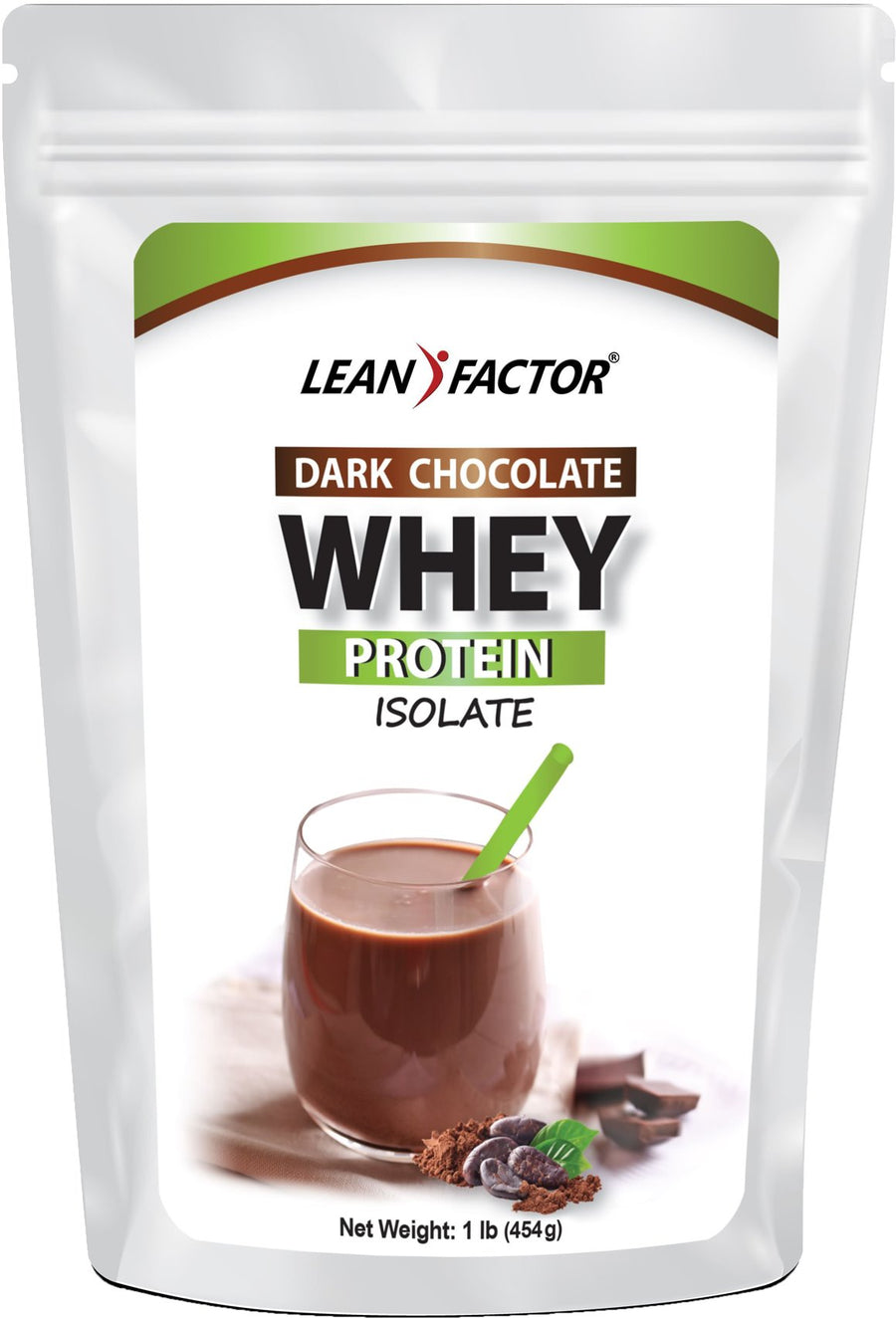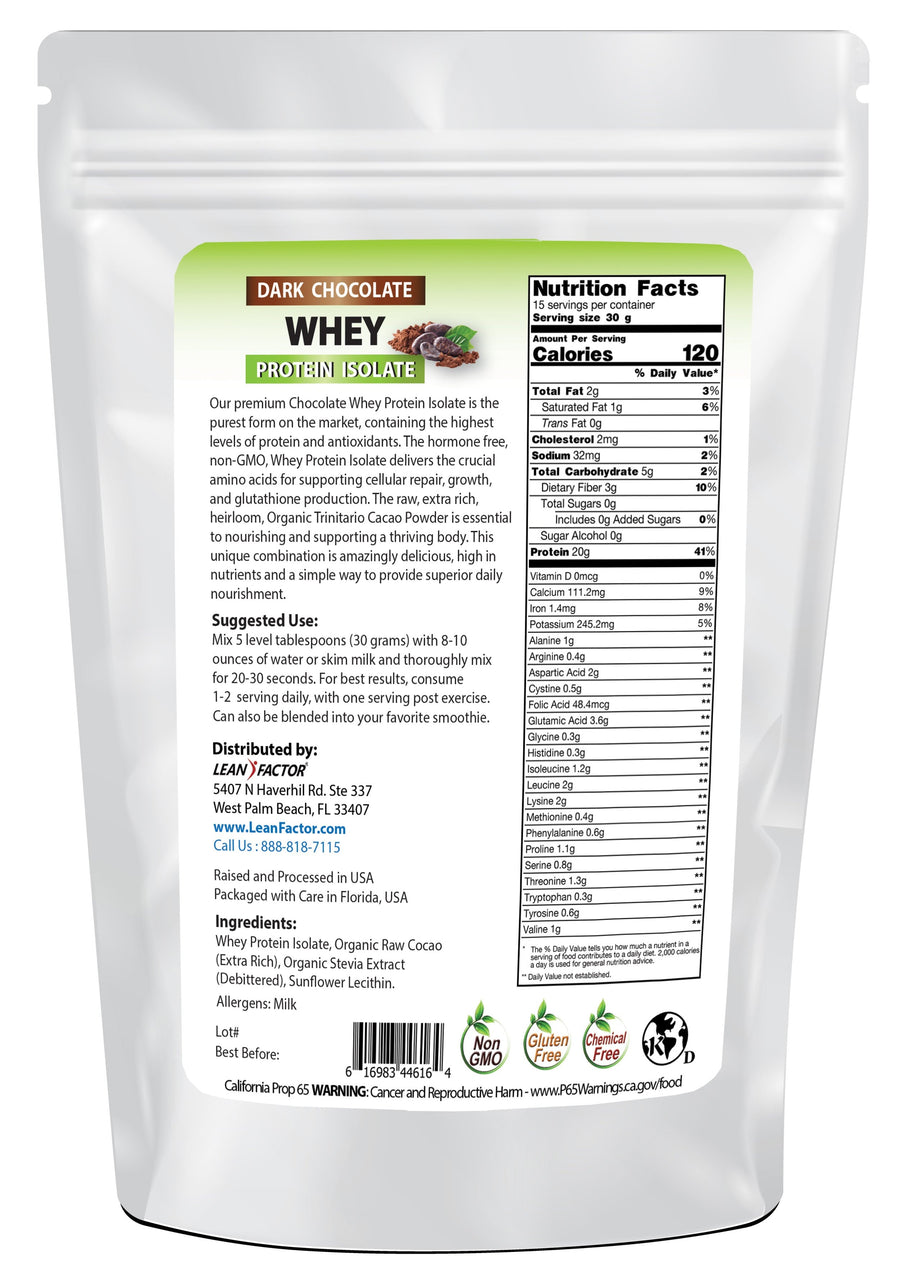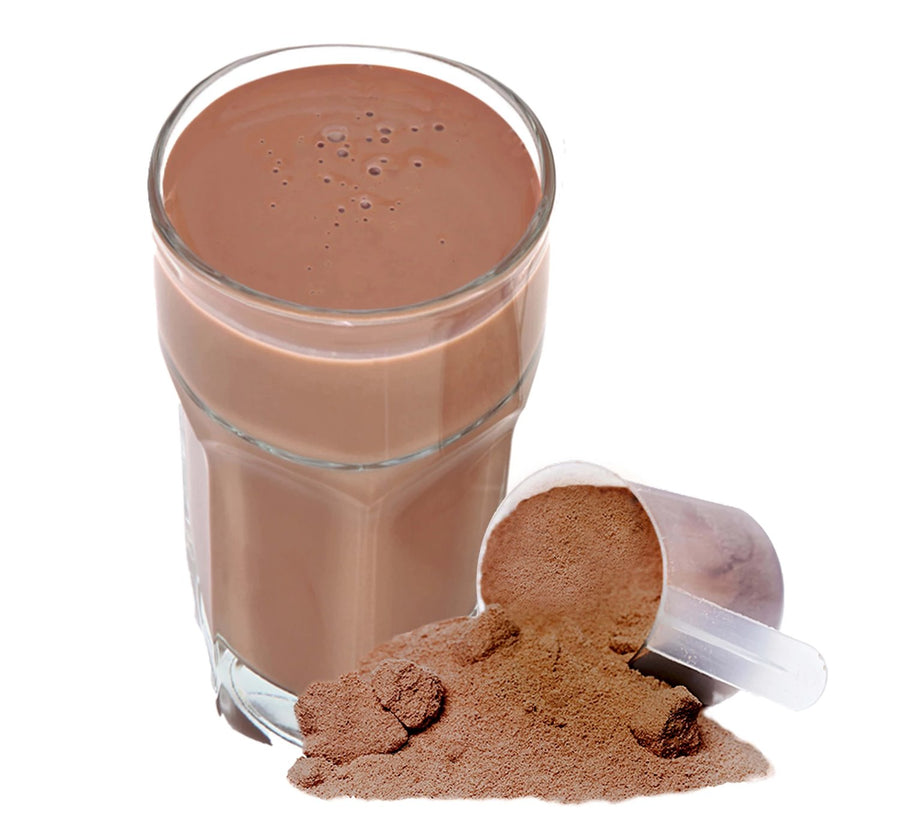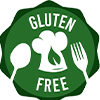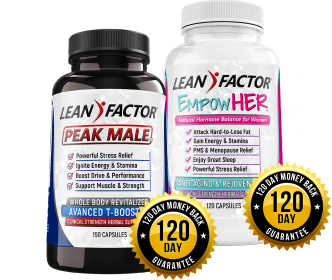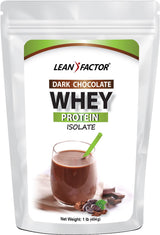Sources & References
1. Fekete, Á.A., et al. (2018). Whey protein lowers blood pressure and improves endothelial function and lipid biomarkers in adults with prehypertension and mild hypertension: the chronic Whey2Go randomized controlled trial results. The American Journal of Clinical Nutrition, 108(6), 1249-1260.
2. Maruyama, S., et al. (2010). Whey protein isolate attenuates force decline after eccentrically-induced muscle damage in healthy individuals. Journal of the International Society of Sports Nutrition, 7, 30.
3. Cornish, J., et al. (2004)
4. Ha, E., and Zemel, M.B. (2003). Functional properties of whey, whey components, and essential amino acids: mechanisms underlying health benefits for active people (review). The Journal of Nutritional Biochemistry, 14(5), 251-258.
5.Hoffman, J.R., and Falvo, M.J. (2004). Protein – Which is Best? Journal of Sports Science and Medicine, 3(3), 118-130.
6. Paoletti, R., et al. (2015). The chemistry of cacao. In The Biochemistry of Chocolate.
7. Sokolov, A.N., et al. (2013). Chocolate and the brain: neurobiological impact of cocoa flavanols on cognition and behavior. Neuroscience & Biobehavioral Reviews, 37(10 Pt 2), 2445–2453.
8. Carakostas, M.C., et al. (2012). Overview: The history, technical function and safety of rebaudioside A, a naturally occurring steviol glycoside, for use in food and beverages. Food and Chemical Toxicology, 46(7 Suppl), S1-S10.
9. Zimecki, M., and Kruzel, M.L. (2007). Milk-derived proteins and peptides in clinical trials. Postepy Hig Med Dosw (Online), 61, 451-462.
10. Micke, P., et al. (2001). Oral supplementation with whey proteins increases plasma glutathione levels of HIV-infected patients. European Journal of Clinical Investigation, 31(2), 171-178.
11. Fekete, Á.A., et al. (2018). Whey protein lowers blood pressure and improves endothelial function and lipid biomarkers in adults with prehypertension and mild hypertension: results from the chronic Whey2Go randomized controlled trial. The American Journal of Clinical Nutrition, 108(6), 1249-1260.
12. Maruyama, S., et al. (2010). Whey protein isolate attenuates force decline after eccentrically-induced muscle damage in healthy individuals. Journal of the International Society of Sports Nutrition, 7, 30.
13. Cornish, J., et al. (2004). Lactoferrin is a potent regulator of bone cell activity and increases bone formation in vivo. Endocrinology, 145(9), 4366–4374.
14. LeBlanc, J.G., et al. (2017). Beneficial effects on host energy metabolism of short-chain fatty acids and vitamins produced by commensal and probiotic bacteria. Microb Cell Fact, 16, 79.
15. Currais A, Maher P. Functional consequences of age-dependent changes in glutathione status in the brain. Antioxid Redox Signal. 2013 Feb 5.
16. Shertzer HG, Woods SE, Krishan M, Genter MB, Pearson KJ. Dietary whey protein lowers metabolic disease risk in mice fed a high-fat diet. J Nutr. 2011 Apr 1;141(4):582-7.
17. Paddon-Jones D, Short KR, Campbell WW, Volpi E, Wolfe RR. Role of dietary protein in the sarcopenia of aging. Am J Clin Nutr. 2008 May;87(5):1562S-6S.
18. Pepe G, Tenore GC, Mastrocinque R, Stusio P, Campiglia P. Potential anticarcinogenic peptides from bovine milk. J Amino Acids. 2013;2013:939804.
19. Markus CR, Olivier B, de Haan EH. Whey protein is rich in alpha-lactalbumin, increases the ratio of plasma tryptophan to the sum of the other large neutral amino acids, and improves cognitive performance in stress-vulnerable subjects. Am J Clin Nutr. 2002 Jun;75(6):1051-6.
20. Visvanathan R, and Chapman IM. Undernutrition and anorexia in the older person. Gastroenterol Clin North Am. 2009;38:393-409.
21. Ahmed T, and Haboubi N. Assessment and management of nutrition in older people and its importance to health. Clin Interv Aging. 2010;5:207-16.
22. Chapman IM. Nutritional disorders in the elderly. Med Clin North Am. 2006;90:887-907.
23. Ahmed N, Mandel R, and Fain MJ. Frailty: An emerging geriatric syndrome. Am J Med. 2007;120:748-53.
24. Heilbronn LK, de Jonge L, Frisard MI, et al. Effect of 6-month calorie restriction on biomarkers of longevity, metabolic adaptation, and oxidative stress in overweight individuals: A randomized controlled trial. JAMA. 2006;295:1539-48.
25. Ingram DK, Roth GS. Glycolytic inhibition as a strategy for developing calorie restriction mimetics. Exp Gerontol. 2011;46:148-54.
26. Ingram DK, Zhu M, Mamczarz J, et al. Calorie restriction mimetics: an emerging research field. Aging Cell. 2006 Apr;5(2):97-108.
27. Solerte SB, Gazzaruso C, Bonacasa R, et al. Nutritional supplements with oral amino acid mixtures increase whole-body lean mass and insulin sensitivity in elderly subjects with sarcopenia. Am J Cardiol. 2008;101:69E-77E.
28. Available at http://www.encognitive.com/files/Potential%20benefits%20of%20improved% 20protein%20intake%20in%20older%20people.pdf. Accessed June 12, 2013.
29. Nair KS, Short KR. Hormonal and signaling role of branched-chain amino acids. J Nutr. 2005 Jun;135(6 Suppl):1547S-52S.
30. Available at http://www.cdc.gov/nchs/fastats/lifexpec.htm. Accessed June 12, 2013.
31. Lan-Pidhainy X, Wolever TM. The hypoglycemic effect of fat and protein is not attenuated by insulin resistance. Am J Clin Nutr. 2010 Jan;91(1):98-105.
32. Jakubowicz D, Froy O. Biochemical and metabolic mechanisms by which dietary whey protein may combat obesity and type 2 diabetes. J Nutr Biochem. 2013 Jan;24(1):1-5.
33. Hall WL, Millward DJ, Long SJ, Morgan LM. Casein and Whey affect plasma amino acid profiles, gastrointestinal hormone secretion, and appetite differently. Br J Nutr. 2003;89:239-48.
34. Pal S, Ellis V. The acute effects of four protein meals on insulin, glucose, appetite, and energy intake in lean men. Br J Nutr. 2010;104:1241-8.
35. Veldhorst MA, Nieuwenhuizen AG, Hochstenbach-Waelen A, et al. Dose-dependent satiating effect of Whey relative to casein or soy. Physiol Behav. 2009;96:675-82.
36. Bowen J, Noakes M, Trenerry C, Clifton PM. Energy intake, ghrelin, and cholecystokinin after different carbohydrate and protein preload in overweight men. J Clin Endocrinol Metab. 2006;91:1477-83.
37. Baer DJ, Stote KS, Paul DR, Harris GK, Rumpler WV, Clevidence BA. Whey protein but not soy protein supplementation alters body weight and composition in free-living overweight and obese adults. J Nutr. 2011;141:1489-94.
38. Dangin M, Boirie Y, Guillet C, Beaufrere B. Influence of the protein digestion rate on protein turnover in young and elderly subjects. J Nutr. 2002 Oct;132(10):3228S-33S.
39. Available at http://www.usdec.org/files/PDFs/2008Monographs/WeighWeightManagement_English.pdf. Accessed June 13, 2013.
40. Doherty TJ. Invited review: Aging and sarcopenia. J Appl Physiol. 2003. 95(4):1717-27.
41. Graf S, Egert S, Heer M. Effects of whey protein supplements on metabolism: evidence from human intervention studies. Curr Opin Clin Nutr Metab Care. 2011 Nov;14(6):569-80.
42. Paddon-Jones D, Sheffield-Moore M, Katsanos CS, Zhang XJ, Wolfe RR. Differential stimulation of muscle protein synthesis in elderly humans following isocaloric ingestion of amino acids or whey protein. Exp Gerontol. 2006 Feb;41(2):215-9.
43. McKiernan SH, Colman RJ, Lopez M, et al. Caloric restriction delays aging-induced cellular phenotypes in rhesus monkey skeletal muscle. Exp Gerontol. 2011 January;46(1):23-9.
44. Paddon-Jones D, Short KR, Campbell WW, Volpi E, Wolfe RR. Role of dietary protein in the sarcopenia of aging. Am J Clin Nutr. 2008 May;87(5):1562S-6S.
45. Koopman R, Verdijk L, Manders RJ, et al. Co-ingestion of protein and leucine stimulates muscle protein synthesis rates to the same extent in young and elderly lean men. Am J Clin Nutr. 2006 Sep;84(3):623-32.
46. Dardevet D, Sornet C, Balage M, Grizard J. Stimulation of in vitro rat muscle protein synthesis by leucine decreases with age. J Nutr. 2000 Nov;130(11):2630-5.
47. Katsanos CS, Kobayashi H, Sheffield-Moore M, Aarsland A, Wolfe RR. A high proportion of leucine is required for optimal muscle protein synthesis stimulation by essential amino acids in the elderly. Am J Physiol Endocrinol Metab. 2006 Aug;291(2): E381-7.
48. Fujita S, Dreyer HC, Drummond MJ, et al. Nutrient signaling in human muscle protein synthesis regulation. J Physiol. 2007 Jul 15;582(Pt 2):813-23.
49. Dreyer HC, Drummond MJ, Pennings B, et al. After resistance exercise, leucine-enriched essential amino acid and carbohydrate ingestion enhance mTOR signaling and protein synthesis in human muscle. Am J Physiol Endocrinol Metab. 2008 Feb;294(2):E392-400.
50. Fujita S, Volpi E. Amino acids and muscle loss with aging. J Nutr. 2006 Jan;136(1 Suppl):277S-80S.
51. Morley JE, Thomas DR, Wilson MM. Cachexia: pathophysiology and clinical relevance. Am J Clin Nutr. 2006 Apr;83(4):735-43.
52. Hack V, Schmid D, Breitkreutz R, et al. Cystine levels, cystine flux, and protein catabolism in cancer cachexia, HIV/SIV infection, and senescence. FASEB J. 1997 Jan;11(1):84-92.
53. Dillon EL, Basra G, Horstman AM, et al. Cancer cachexia and anabolic interventions: a case report. J Cachexia Sarcopenia Muscle. 2012 Dec;3(4):253-63.
54. Bounous G, Baruchel S, Falutz J, Gold P. Whey proteins as a food supplement in HIV-seropositive individuals. Clin Invest Med. 1993 Jun;16(3):204-9.
55. Aoe S, Toba Y, Yamamura J, et al. Controlled trial of the effects of milk basic protein (MBP) supplementation on bone metabolism in healthy adult women. Biosci Biotechnol Biochem. 2001;65:913-8.
56. Parodi PW. A role for milk proteins and their peptides in cancer prevention. Curr Pharm Des. 2007;13(8):813-28.
57. McIntosh GH, Regester GO, Le Leu RK, Royle PJ, Smithers GW. Dairy proteins protect against dimethylhydrazine-induced intestinal cancers in rats. J Nutr. 1995 Apr;125(4):809-16.
58. Tsuda H, Sekine K, Ushida Y, et al. Milk and dairy products in cancer prevention: focus on bovine lactoferrin. Mutat Res. 2000 Apr;462(2-3):227-33.
59. Available at http://www.cdc.gov/features/vitalsigns/cardiovasculardisease/. Accessed June 14, 2013.
60. Available at http://usdec.files.cms-plus.com/Publications/CardioHealth_English.pdf. Accessed June 14, 2013.
61. Zhang X, Beynen AC. Lowering effect of dietary milk-whey protein v. casein on rats' plasma and liver cholesterol concentrations. Br J Nutr. 1993 Jul;70(1):139-46.
62. Meltzer CC, Smith G, DeKosky ST, et al. Serotonin in aging, late-life depression, and Alzheimer’s disease: the emerging role of functional imaging. Neuropsychopharmacology. 1998 Jun;18(6):407-30.
63. Meltzer CC, Price JC, Mathis CA, et al. Serotonin 1A receptor binding and treatment response in late-life depression. Neuropsychopharmacology. 2004 Dec;29(12):2258-65.
64. Fernstrom JD, Wurtman RJ. Brain serotonin content: physiological dependence on plasma tryptophan levels. Science. 1971;173:149-52.
65. Fernstrom JD, Wurtman RJ. Brain serotonin content: physiological regulation by plasma neutral amino acids. Science. 1972;178:414-6.
66. Markus CR, Olivier B, Panhuysen GE, et al. The bovine protein alpha-lactalbumin increases the plasma ratio of tryptophan to the other large neutral amino acids in vulnerable subjects, raises brain serotonin activity, reduces cortisol concentration, and improves mood under stress. Am J Clin Nutr. 2000 Jun;71(6): 1536-44.
67. Markus CR, Olivier B, de Haan EH. Whey protein is rich in alpha-lactalbumin, increases the ratio of plasma tryptophan to the sum of the other large neutral amino acids, and improves cognitive performance in stress-vulnerable subjects. Am J Clin Nutr. 2002 Jun;75(6):1051-6.
68. Camfield DA, Owen L, Scholey AB, Pipingas A, Stough C. Dairy constituents and neurocognitive health in aging. Br J Nutr. 2011 Jul;106(2):159-74.
69. Chatterton DE, Nguyen DN, Bering SB, Sangild PT. Anti-inflammatory mechanisms of bioactive milk proteins in the intestine of newborns. Int J Biochem Cell Biol. 2013 May 6.
70. Rahman I, MacNee W. Oxidative stress and glutathione regulation in lung inflammation. Eur Respir J. 2000 Sep;16(3):534-54.
71. Buffinton GD, Doe WF. We depleted mucosal antioxidant defenses in inflammatory bowel disease—free Radic Biol Med. 1995;19:911-8.
72. Duggan C, Stark AR, Auestad N, et al. S. Collier. 2004. Glutamine supplementation in infants with gastrointestinal disease: a randomized, placebo-controlled pilot trial. Nutrition.2004;20:752-6.
73. Walzem RL, Dillard CJ, German JB. Whey components: millennia of evolution create functionalities for mammalian nutrition: What we know and may be overlooking. Crit Rev Food Sci Nutr.
2002;42:353-75.
74. Fioramonti J, Theodorou V, Bueno L. Probiotics: what are they? What are their effects on gut physiology? Best Pract Res Clin Gastroenterol. 2003;17:711-24.
75. Teitelbaum JE, Walker WA. Nutritional impact of pre-and probiotics as protective gastrointestinal organisms. Annu Rev Nutr 2002;22:107-38.
76. Matsumoto H, Shimokawa Y, Ushida Y, Toida T, Hayasawa H. New biological function of bovine alpha-lactalbumin: Protective effect against ethanol- and stress-induced gastric mucosal injury in rats. Biosci Biotechnol Biochem. 2001 May;65(5):1104-11.
77. Cross ML, Gill HS. Immunomodulatory properties of milk. Brit J Nutr. 2000;84:S81-9.
78. Clare DA, Swaisgood HE. Bioactive milk peptides: A prospectus. J Dairy Sci. 2000;83:1187-95.
79. Low PPL, Rutherford KJ, Gill HS, Cross ML. Effect of dietary whey protein concentrate on primary and secondary antibody responses in immunized BALB/C mice. Int Immunopharmacol. 2003;3:393-401.
80. Bounous G, Kongshavn PA, Gold P. The immunoenhancing property of dietary whey protein concentrate. Clin Invest Med. 1988 August;11(4):271-8.
81. Bounous G, Papenburg R, Kongshavn PA, Gold P, Fleiszer D. Dietary whey protein inhibits dimethylhydrazine-induced malignancy development. Clin Invest Med. 1988;11(3)213-7.
82. Ford JT, Wong CW, Colditz IG. Effects of dietary protein types on immune responses and infection levels with Eimeria vermiformis in mice. Immunol Cell Biol 2001;79(1):23-8.
83. Bounous G, Kongshavn PA. Differential effect of dietary protein type on mice's B-cell and T-cell immune responses. J Nutr. 1985;115(11):1403-8.
84. McCay CM, Crowel MF. Prolonging the life span. Scientific Monthly. 1934 Nov;39(5):405-14.
85. McCay CM, Crowell MF, Maynard LA. The effect of retarded growth upon the length of life span and the ultimate body size. Nutrition. 1935;5:155-71.
86. Ward PP, Paz E, Conneely OM. Multifunctional roles of lactoferrin: a critical overview. Cell Molecular Life Sci. 2005;62,2540-8.
87. Wakabayashi H, Yamauchi K, Takase M. Inhibitory effects of bovine lactoferrin and lactoferricin B on Enterobacter sakazakii. Biocontrol Sci. 2008;13:29-32.
88. Liepke C, Adermann K, Raida M, et al. Human milk provides peptides that highly stimulate bifidobacteria’s growth. Eur J Biochem. 2002;269:712-8.
89. Okazaki Y, Kono I, Kuriki TJ, et al. Bovine lactoferrin ameliorates ferric nitrilotriacetate-induced renal oxidative damage in rats. Clin Biochem Nutr. 2012 Sep;51(2):84-90.
90. Raghuveer TS, McGuire EM, Martin SM, et al. Lactoferrin in the preterm infants”’ diet attenuates iron-induced oxidation products. Pediatr Res. 2002;52:964-72.
91. Shoji H, Oguchi S, Shinohara K, et al. Effects of iron-unsaturated human lactoferrin on hydrogen peroxide-induced oxidative damage in intestinal epithelial cells. Pediatr Res. 2007;61:89-92.
92. Iigo M, Shimamura M, Matsuda E, et al. Orally administered bovine lactoferrin induces caspase-1 and interleukin-18 in the mouse intestinal mucosa: a possible explanation for inhibiting carcinogenesis and metastasis. Cytokine. 2004;25:36-44.
93. Oguchi S, Walker WA, Sanderson IR. Iron saturation alters lactoferrin’s effect on the proliferation and differentiation of human enterocytes (Caco-2 cells). Biol Neonate. 1995;67:330-9.
94. Spadaro M, Caorsi C, Ceruti P, et al. Lactoferrin, a significant defense protein of innate immunity, is a novel maturation factor for human dendritic cells. FASEB J. 2008;22:2747-57.
95. Ashida K, Sasaki H, Suzuki YA, Lonnerdal B. Cellular internalization of lactoferrin in intestinal epithelial cells. Biometals. 2004;17:311-5.
96. Garre C, Bianchi-Scarra G, Sirito M, et al. Lactoferrin binding sites and nuclear localization in K562(S) cells. J Cell Physiol. 1992;153:477-82.
97. Tung YT, Chen HL, Yen CC, et al. Bovine lactoferrin inhibits lung cancer growth by suppressing inflammation and vascular endothelial growth factor expression. J Dairy Sci. 2013 Apr;96(4):2095-106.
98. Ono T, Murakoshi M, Suzuki N, et al. Potent anti-obesity effect of enteric-coated lactoferrin: decrease in Japanese men’s visceral fat accumulation and women with abdominal obesity after 8-week administration of enteric-coated lactoferrin tablets. Br J Nutr. 2010 Dec;104(11):1688-95.
99. Maher P. Modulation of multiple pathways involved in maintaining neuronal function during aging by fisetin. Genes Nutr. 2009 Sep 10.
100. Sadruddin S, Arora R. Resveratrol: biologic and therapeutic implications. J Cardiometab Syndr. 2009 Spring;4(2):102-6.
101. Joseph JA, Fisher DR, Cheng V, Rimando AM, Shukitt-Hale B. Cellular and behavioral effects of stilbene resveratrol analogs: implications for reducing the deleterious effects of aging. J Agric Food Chem. 2008 Nov 26;56(22):10544-51.
102. Salas A, Subirada F, Perez-Enciso M, et al. Plant polyphenol intake alters gene expression in canine leukocytes. J Nutrigenet Nutrigenomics. 2009;2(1):43-52.
103. Ruiz PA, Braune A, Holzlwimmer G, Quintanilla-Fend L, Haller D. Quercetin inhibits TNF-induced NF-kappaB transcription factor recruitment proinflammatory gene promoters in murine intestinal epithelial cells. J Nutr. 2007 May;137(5):1208-15.
104. Widlansky ME, Duffy SJ, Hamburg NM, et al. Effects of black tea consumption on plasma catechins and markers of oxidative stress and inflammation in patients with coronary artery disease. Free Radic Biol Med. 2005 Feb 15;38(4):499-506.
105. http://www.naturalnews.com/045202_whey_protein_obesity_diabetes_prevention.html
106. http://www.acs.org/content/acs/en/pressroom/presspacs/2014/acs-presspac-april-30-2014/whey-beneficially-affects-diabetes-and-cardiovascular-disease-risk-factors-in-obese-adults.html
107. http://www.diabetes.co.uk/news/2014/may/whey-protein-linked-to-lower-diabetes-risk-in-obese-adults-94407038.html
108. http://www.sciencedaily.com/releases/2013/10/131010091557.htm
109. http://www.sciencedaily.com/releases/2010/12/101208125624.htm
110. Valerio A, D “‘Antona G, Nisoli E. Branched-chain amino acids, mitochondrial biogenesis, and healthspan: an evolutionary perspective. Aging (Albany, NY). 2011 May;3(5):464-78.
112. D'Antona G, Ragni M, Cardile A, et al. Branched-chain amino acid supplementation promotes survival and supports cardiac and skeletal muscle mitochondrial biogenesis in middle-aged mice. Cell Metab. 2010 October;12(4):362-72.
113. Alvers AL, Fishwick LK, Wood MS, Hu D, Chung HS, Dunn WA, and Aris JP. Autophagy and amino acid homeostasis are required for chronological longevity in Saccharomyces cerevisiae. Aging Cell. 2009;8:353-69.
114. Fuchs S, Bundy JG, Davies SK, Viney JM, Swire JS, and Leroi AM. A metabolic signature of long life in Caenorhabditis elegans. BMC Biol. 2010;8:14.
115. Yalçin AS. Emerging therapeutic potential of whey proteins and peptides. Curr Pharm Des. 2006;12(13):1637-43.
116. Krissansen GW. Emerging health properties of whey proteins and their clinical implications. J Am Coll Nutr. Dec. 2007;26(6):713S-23S.
117. Vegarud GE, Langsrud T, Svenning C. Mineral-binding milk proteins and peptides; occurrence, biochemical and technological characteristics. Br J Nutr. 2000;84(Suppl 1): S91-8.
118. Available at http://www.innovatewithdairy.com/SiteCollectionDocuments/Mono_Immunity_0304.pdf. Accessed June 12, 2013.
119. Kent KD, Harper WJ, Bomser JA. Effect of whey protein isolates on intracellular glutathione and oxidant-induced cell death in human prostate epithelial cells. Toxicol In Vitro. 2003 Feb;17(1):27-33.
120. Bounous G, Gervais F, Amer V, Batist G, Gold P. The influence of dietary whey protein on tissue glutathione and aging diseases. Clin Invest Med. 1989;12:343-9.
121. Townsend DM, Tew KD, Tapiero H. The importance of glutathione in human disease. Biomed Pharmacother. 2003 May-Jun;57(3-4):145-55.
122. Wu G, Fang YZ, Yang S, Lupton JR, Turner ND. Glutathione metabolism and its health implications. J Nutr. 2004 Mar;134(3):489-92.
123. Katsanos CS, Chinkes DL, Paddon-Jones D, Zhang XJ, Aarsland A, Wolfe RR. Whey protein ingestion in elderly persons results in greater muscle protein accrual than ingesting its constituent essential amino acid content. Nutr Res. 2008 Oct;28(10):651-8.
124. Bounous G, Batist G, Gold P. Immunoenhancing property of dietary whey protein in mice: role of glutathione. Clin Invest Med. 1989 Jun;12(3):154-61.
125. Daley, C.A., et al. (2010). Nutrition Journal, 9, 10. Retrieved from https://www.ncbi.nlm.nih.gov/pmc/articles/PMC2846864/
126. Benbrook, C.M. et al. (2013). PLoS ONE, 8(12), e82429. Retrieved from https://www.ncbi.nlm.nih.gov/pmc/articles/PMC3857248/


